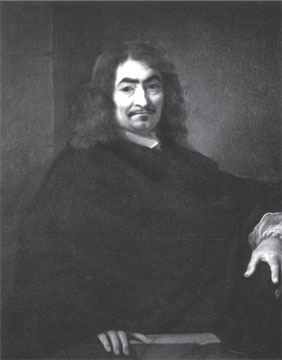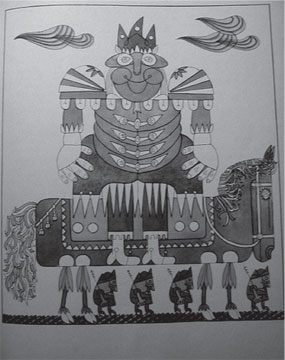French Renaissance literature
 The current series of columns on French literary movements has, until
now, primarily focused on Medieval literature. This study has included a
review of Arthurian legends and fables, farces and morality tales. Among
the texts examined are 'Roman de la Rose' (and related poetry), and 'La
Chatelaine de Vergy'. These, among other tales of French courtly love,
were important precursors to a number of French Renaissance texts, which
are the subject of this column. The current series of columns on French literary movements has, until
now, primarily focused on Medieval literature. This study has included a
review of Arthurian legends and fables, farces and morality tales. Among
the texts examined are 'Roman de la Rose' (and related poetry), and 'La
Chatelaine de Vergy'. These, among other tales of French courtly love,
were important precursors to a number of French Renaissance texts, which
are the subject of this column.
The late 15th and early 16th century saw the birth of the Renaissance
in France. The civil and religious strife of the later 16th century was
reflected clearly in the period. Under the stable and prosperous Bourbon
monarchy, Paris became the glittering cultural centre of Western
civilisation. Literature during the French Renaissance passed through
four fairly distinct phases. Each new generation of writers developed
its own set of ideas and styles. Many important works of this period are
difficult to place within specific genres, or literary forms. Writers
often created new forms by combining elements of various older
traditions.
The first generation included Clément Marot, Margaret of Navarre, and
François Rabelais. These writers borrowed the forms and customs of
medieval literature, but used them to express anti-medieval ideas and
beliefs. Marot's earliest poems are allegories in the tradition of the
Roman de la Rose (Romance of the Rose), a long French poem about courtly
love, which was studied in the 20th March - 'Fabliaux, Farces and
Morality Tales'.
Margaret of Navarre also wrote several plays similar in style and
form to medieval farces, but with a new emphasis on religious themes.
She also copied the short, humorous, and often obscene stories of the
Middle Ages in her Cent Nouvelles (One Hundred Stories). However, this
collection of tales also reflects the influence of Boccaccio's
Decameron, leading some scholars to call it the Heptameron. The work
represents the finest body of short stories from the French Renaissance.
 |
|
Descartes |
Rabelais is the possibly the most groundbreaking writer of this
generation. In his long narrative Pantagruel, he borrowed from the
tradition of the medieval epic, but at the same time moved far beyond
it. The result was an entirely new form of heroic fiction more in tune
with the author's humanist views. Combining humour with impressive
scholarship, Rabelais recounted the adventures of giant heroes who are
saved from a life of ignorance and brutality by a humanist education.
They eventually save the world from the flawed political, religious, and
scholarly ideas of the Middle Ages. In later sections, Rabelais broke
away from the epic tradition completely to explore the limits of human
knowledge and the idea of the abuse of power.
The Pléiade
In the mid-1500s, a group of poets known as the Pléiade (a name based
on Greek mythology) set out to make a clean break from the literary
traditions of the Middle Ages. They systematically rejected all forms
and customs of the French literary tradition and sought to return to
ancient Greek and Latin models. Their aim was to sweep away all traces
of the Middle Ages, which they saw as a period of ignorance, and raise
the French language and culture to the heights reached by ancient Greece
and Rome.
Joachim du Bellay expressed this ambitious goal in his Defense and
Illustration of the French Language. He saw this work as the most
important turning point in the history of French literature. Along with
the Defense, du Bellay published a collection of odes modeled on those
of Horace. Pierre de Ronsard, a close associate of du Bellay, published
a longer collection of poems that re-created the structure and style of
Pindar's odes. Étienne Jodelle, another member of the Pléiade, attempted
to revive the forms of classical drama with his tragedy Cleopatra in
Prison and his comedy Eugène.
The next generation of French writers found classical forms and
styles too limiting. They also saw the glory of the ancient world as an
unimportant idea in a country increasingly torn by religious wars. On
August 24, 1572, religious tensions in France burst out in a wave of
killings known as the St. Bartholomew's Day Massacre. This tragedy
inspired a new generation of writers to create violent, intense, and
passionate works with a focus on the inner life of the mind. They began
combining different types of literary forms, creating works that do not
fall into familiar categories. Their works led in the Baroque period in
literature.
Michel de Montaigne was perhaps the most important writer of this
period. Although he admired the classical poems of du Bellay and
Ronsard, he chose to write in a manner that was decidedly anti-classical
in form, style, and purpose. His Essays are essentially exercises in
which he tests his own judgment on a variety of topics. Through these
tests, Montaigne revealed his own personality and his new vision of
reality as uncertain and ever changing. Another great writer of this
period was the poet Agrippa d'Aubigné. A student of classical
literature, he kept some of the lyric forms created by the Pléiade, but
he broke away from their style and filled his work with images of war,
martyrdom, and destruction.
The end of the Renaissance in France
In the first decades of the 1600s, French writers continued the
literary experiments of the previous generation, but in a different way.
They returned to familiar literary forms and created new ones to express
both the passions of the soul and the workings of the mind. Theatre
became the most popular form of literature during this period.
Playwrights mixed genres to produce new types of drama, such as
tragicomedy and the pastoral play.
The so-called libertine poets revived the poetic tradition with their
spirited verses about the pleasures of the tavern and the brothel, the
wretchedness of poverty, and the sources of poetic inspiration. They
used forms first invented by the Pléiade but also drew on the works of
earlier writers. When this generation of poets died out, lyric poetry
effectively ended in France for more than a century.
In the area of prose, autobiographies became popular. Perhaps the
greatest of these was Discourse on Method by the noted scientist and
philosopher René Descartes. The book traced the author's intellectual
development and described his method of inquiry in a style that
reflected the Essays of Montaigne. Montaigne's work also inspired author
Charles Sorel, who drew on a great variety of literary forms to create
the first authentic novel in French. In addition to Montaigne, his
sources included French nouvelles (short stories), libertine poetry, and
the Spanish picaresque novel (a story about the adventures of a rogue or
rascal).
In spite of the fact that the general view is that the French
Renaissance began in the 15th century, some scholars claim that the
French Renaissance really began in the late 1400s, when the Italian
writers Petrarch and Giovanni Boccaccio first began to have an influence
on French literature. In either case, France's Renaissance began much
later than Italy's, and as a result, it was shaped by very different
forces.
Humanism and Religious Wars
While the Italian Renaissance focused on reviving classical culture,
the French Renaissance began mainly as a religious movement. France was
a major center of theology and French thinkers had a stronger interest
in recovering the texts of early Christianity than in the pagan
literature of ancient Greece and Rome. Trends and ideas from northern
Europe played a major role in the French Renaissance.
The Dutch humanist Desiderius Erasmus, who tried to return the church
to its early Christian roots, inspired the first wave of French
Renaissance writers. Clément Marot translated several pieces by Erasmus
and composed allegorical poems about the rebirth of pure Christianity.
In addition, he translated nearly 50 psalms into French verse that
ordinary people could sing as they worked. Erasmus's literary techniques
also had a great influence on François Rabelais, who produced works of
biting satire attacking the Christianity of his day.
Religious reformer Martin Luther also had a strong influence on
French writers, especially Margaret of Navarre. Her poems, plays, and
other works combined elements of Luther's theology with the mysticism of
the late Middle Ages. Many of her pieces portrayed humble souls who were
saved by the mystery of God's grace.
 |
|
Pantagruel by Rabelais |
Through Margaret, Luther's views influenced the circle of young
writers she supported and promoted, which included the young John
Calvin. The Protestant Reformation in France set off a bloody civil war
between Protestants and Catholics. Many writers took sides in the
religious conflict. The Catholic author Pierre de Ronsard attacked
Protestant beliefs and practices, while the Protestant Henri Estienne
mocked what he saw as the superstitions of the Catholic Church.
Classical literature and philosophy
By the time the French turned to the classics for inspiration, they
had access to a great number of ancient Greek and Roman works that had
not been available to earlier writers. New advances in printing made
these literary works easier to find and read than ever before. French
writers also had an advantage in trying to understand these works.
Italian scholars had made great advances in the study of Greek in the
previous 200 years, and many Greek scholars had moved to western Europe
in the 1400s, bringing their learning and libraries with them. By the
time of the French Renaissance, writers could study the Greek language
or read Greek works in Latin translation.
These advances in classical studies had a decided influence on French
writers. Rabelais, for example, knew enough Greek to lecture and write
commentaries on the works of the ancient physicians Galen and
Hippocrates. Poets of the mid-1500s, such as Ronsard and Joachim du
Bellay, studied the works of ancient Greek and Roman poets, such as
Virgil, Horace, Pindar, and Homer. Enthusiasm for these ancient writers
inspired them to compose their own poetry in French. Many writers also
admired the works of classical philosophers, such as Plato, Lucretius,
and Seneca.
Italian literature
French writers studied Italian literature to find new ways of writing
in the vernacular. French art and literary works of the late 1400s
already show distinct Italian influences. In the 1530s, a major phase of
Italian influence began in the city of Lyon, in southern France.
A large number of Italians lived in Lyon, and many Italian books were
published there. One of them, Petrarch's Canzoniere (Book of Songs),
became the model for a new kind of French poetry. Clément Marot
translated several poems from the Canzoniere and composed what may have
been the first original sonnet in French. Maurice Scève published the
first French "canzoniere" in direct imitation of Petrarch. The Italian
sonnet replaced all French lyric forms as the standard for love poetry.
French poets composed collections of sonnets devoted to a single lady,
just as Petrarch had done.
French writers also imitated other Italian works, such as the
Decameron by Giovanni Boccaccio and The Book of the Courtier by
Baldassare Castiglione. Orlando Furioso (Mad Roland), a long poem by
Ludovico Ariosto, inspired French writers in a less direct way. It
provided a stock of well-known characters, situations, and speeches that
appeared in all forms of literature.
Italian influences on French literature remained strong until the
late 1500s, when writers turned against the Italian style-largely
because of anti-Roman Catholic religious feelings.
It is beyond the scope of this one column to study each of the most
important works associated with French Renaissance Literature. As it is
a large topic, individual works will be reviewed in future columns.
|

